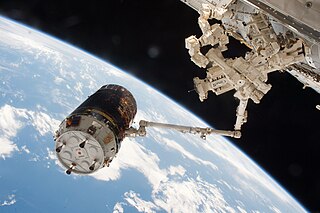Related Research Articles

Royal Space Force: The Wings of Honnêamise is a 1987 Japanese animated science fiction film written and directed by Hiroyuki Yamaga, co-produced by Hiroaki Inoue and Hiroyuki Sueyoshi, and planned by Toshio Okada and Shigeru Watanabe, with music by Ryuichi Sakamoto. The story takes place in an alternate world where a disengaged young man, Shirotsugh, inspired by an idealistic woman, Riquinni, volunteers to become the first astronaut. The film was the debut by the studio Gainax, and the first anime produced by Bandai.
RAIKO is a Japanese satellite which was built and operated by Tohoku and Wakayama Universities. A two-unit CubeSat, RAIKO was deployed from the International Space Station (ISS) on 4 October 2012, having been launched on 21 July 2012.

F-1 is a CubeSat built by FSpace laboratory at FPT University, in Hanoi, Vietnam, in partnership with Angstrom Space Technology Center (ASTC), Uppsala University, Sweden and Nanoracks LLC, United States. Its mission is to train young engineers and students about aerospace engineering and evaluate an advanced three-axis magnetometer, Spin-Dependent Tunneling Magnetometer (SDTM) designed in Sweden by ASTC.

The Epsilon Launch Vehicle, or Epsilon rocket, is a Japanese solid-fuel rocket designed to launch scientific satellites. It is a follow-on project to the larger and more expensive M-V rocket which was retired in 2006. The Japan Aerospace Exploration Agency (JAXA) began developing the Epsilon in 2007. It is capable of placing a 590 kg payload into Sun-synchronous orbit.

WE WISH was a small commercial CubeSat which was deployed from the International Space Station (ISS) in October 2012 and which deorbited in March 2013. It was built by the Japanese technology company Meisei Electric and the Meisei Amateur Radio Club, and could transmit pictures taken by a small infrared camera via radio at 437.515 MHz. WE WISH travelled to orbit aboard Kounotori 3 (HTV-3) on 21 July 2012, along with other CubeSats including RAIKO, FITSAT-1, F-1, and TechEdSat-1.

Kounotori 6 (こうのとり6号機), also known as HTV-6, was the sixth flight of the H-II Transfer Vehicle, an uncrewed cargo spacecraft launched to resupply the International Space Station. It was launched at 13:26:47 UTC on 9 December 2016 aboard H-IIB launch vehicle from Tanegashima Space Center.

Smart Lander for Investigating Moon (SLIM), dubbed "Moon Sniper", was a lunar lander mission of the Japan Aerospace Exploration Agency (JAXA). The lander's initial launch date in 2021 was postponed until 2023 due to delays in its rideshare, the X-Ray Imaging and Spectroscopy Mission (XRISM). On 6 September 2023 at 23:42 UTC, XRISM launched, and SLIM separated from it later that day.

Kounotori 7 (こうのとり7号機), also known as HTV-7, was the seventh flight of the H-II Transfer Vehicle (HTV), an uncrewed cargo spacecraft launched on 22 September 2018 to resupply the International Space Station.
The Innovative Satellite Technology Demonstration Program is a series of spacecraft missions for testing technology and ideas put forward by universities and private companies. The program demonstrates various experimental devices and technology in space by providing flight opportunities. It is managed by the JAXA Research and Development Directorate. According to JAXA, the goal of this program is to test high risk, innovative technology that will lead to the space industry gaining competitiveness in the international field.

RAPIS-1 is a satellite launched on 18 January 2019 which for over a year was used to test seven technology demonstration projects. RAPIS-1 was developed and operated by Axelspace Corporation, under the coordination of the Japanese space agency JAXA.

Sherry Moi Meng Ling is a Malaysian virologist, currently serving as a professor at the Graduate School of Medicine, the University of Tokyo. Her research focuses on innate immune system to mosquito-borne virus infection and field epidemiology.
RSP-01, nicknamed Selfie-sh was a nanosatellite developed by Ryman Sat Project. RSP-01 launched from Wallops Flight Facility on board a Cygnus spacecraft on 20 February 2021.
STARS-EC was a nanosatellite developed by Shizuoka University, for the purpose of demonstrating space elevator tether technology. It was a 3U-size CubeSat, and could split into three separate satellites, connected via tethers. STARS-EC was launched on 20 February 2021, and was deployed from the International Space Station (ISS). The deployment service of STARS-EC was provided by Mitsui Bussan Aerospace.
DRUMS is an experimental spacecraft that will test proximity operation near space debris. The microsatellite carries two 'mock space debris' which once deployed will be used as a target for demonstrating approach and contact.
RAISE-2 was a smallsat for technology demonstration, part of the Japanese space agency JAXA's Innovative Satellite Technology Demonstration Program. RAISE-2 was launched on 9 November 2021 as the main satellite of Innovative Satellite Technology Demonstration-2. RAISE-2 was developed by Mitsubishi Electric.
WARP-01, nicknamed Nichirin, was a 1U-sized CubeSat developed and operated by Warpspace, a newspace company based in Tsukuba, Japan. It was launched on 20 February 2021 on board a Cygnus cargo spacecraft, and deployed from the International Space Station (ISS) on 14 March 2021. WARP-01 was used for technology validation and monitoring the radio wave and radiation environment in space.
KITSUNE was a JAXA nanosatellite developed by the HAK consortium, which consists of Haradaseiki Kogyo, Addnics Corporation, and Kyushu Institute of Technology (Kyutech). The spacecraft was a 6U CubeSat, and carried a high-resolution camera for Earth observation. KITSUNE was carried to the International Space Station (ISS) on board Cygnus NG-17, and was deployed from the ISS's Kibō Module on 24 March 2022 12:10 UTC. The deployment service of KITSUNE was provided by Mitsui Bussan Aerospace.
Mitsuba was a nanosatellite developed by Kyushu Institute of Technology (Kyutech) which would have tested whether products that are not intended for use in space are still usable for satellites. Mitsuba was launched on 12 October 2022 by an Epsilon rocket, but the launch resulted in a failure and the satellite was lost.
SpaceTuna1 is a nanosatellite developed by Kindai University to test the properties of reflective materials in space.The project aims to use this technology to monitor tunas as an alternative to the use of tags for biologging. SpaceTuna1 has been launched from Wallops Flight Facility on board a Cygnus spacecraft on 7 November 2022, and will later be deployed from the International Space Station (ISS).
The Japan Module, also known as the Kibō successor module, is a commercial space module for scientific research being studied by the Japanese space agency JAXA and private venture Japan LEO Shachu, a wholly owned subsidiary of conglomerate Mitsui & Co., that will be docked to a yet-to-be-identified American commercial space station. The module will be placed in low Earth orbit and will primarily be used for biological and material physics research.
References
- 1 2 Shimazaki, Amane (November 20, 2022). "Firms work on growing food in space so humans can live on moon". The Asahi Shimbun . Retrieved 2023-07-19.
- ↑ "Our Business". DigitalBlast. Retrieved 2023-07-19.
- ↑ Yoshida, Hiroshi (October 28, 2023). "宇宙の視点を入れた戦略でビジネスの可能性を拡大する デジタルブラスト 堀口真吾". Keizaikai (in Japanese). Retrieved 2023-07-20.
- ↑ "宇宙ビジネスを推進する株式会社デジタルブラストが、宇宙の知見、知識を体系的に広め、多くの方々の宇宙ビジネスへのニーズを喚起するためのメディア『SPACEMedia(スペースメディア)』をローンチ" (Press release) (in Japanese). DigitalBlast. September 8, 2020. Retrieved July 19, 2023.
- 1 2 "DigitalBlastが月面での生態循環維持システム構築に向けたプロジェクト「NOAH」を本格始動" (Press release) (in Japanese). DigitalBlast. May 17, 2022. Retrieved July 19, 2023.
- ↑ "DigitalBlast、富山大学・唐原一郎教授、蒲池浩之准教授の研究グループと共同研究開始" (Press release) (in Japanese). DigitalBlast. July 13, 2022. Retrieved July 19, 2023.
- ↑ "DigitalBlast、シクロと重力発生装置「AMAZ(アマツ)」の利用を含めた業務委託契約を締結" (Press release) (in Japanese). DigitalBlast. July 20, 2022. Retrieved July 19, 2023.
- ↑ "DigitalBlast、東京大学・大矢禎一教授と奈良先端科学技術大学院大学・渡辺大輔准教授の研究グループ、シクロと共同研究開始" (Press release) (in Japanese). DigitalBlast. January 31, 2023. Retrieved July 19, 2023.
- 1 2 "DigitalBlast, Inc. signed Service Contract with Axiom Space, Inc., a U.S. company, including the launch of compact life-science experimental device "AMAZ" planned in 2024" (Press release). DigitalBlast. November 1, 2022. Retrieved July 19, 2023.
- ↑ "当社仲介によりAxiom Space, Inc.が、株式会社DigitalBlastと国際宇宙ステーションでの実証実験実施に関する業務委託契約を締結" (Press release) (in Japanese). Mitsui Bussan Aerospace. January 17, 2023. Retrieved July 19, 2023.
- ↑ "DigitalBlast、小型ライフサイエンス実験装置「AMAZ(アマツ)」のフライトモデル開発・製造に向け、三菱重工へ設計を委託 2024年のISS設置・運用を目指す宇宙実験装置の開発・製造をさらに加速" (Press release) (in Japanese). DigitalBlast. November 24, 2022. Retrieved July 19, 2023.
- ↑ Haru, Kyusen (February 9, 2023). "DigitalBlast、ISSでの細胞実験を実現する小型実験装置の開発を開始". Mynavi news (in Japanese). Retrieved 2023-07-19.
- ↑ "ElevationSpaceとDigitalBlast、低重力環境での植物栽培実験環境提供のため、小型宇宙利用・回収プラットフォームの利用に向けMOUを締結" (Press release) (in Japanese). Elevation Space. August 17, 2022. Retrieved July 19, 2023.